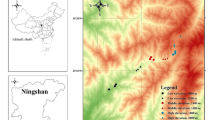Abstract
Taxonomic ranks from species to superorder were evaluated for their usefulness as ecological descriptors. For qualitative or quantitative data, large or small scale, superorder descriptors retain much of the information of species. Examination of species-poor qualitative data (14 species/5 superorders, i.e. 64% fewer descriptors) resulted in group memberships of classifications as much as 87% similar. Similarly, species-rich quantitative data (208 species/23 superorders, i.e. 88% fewer descriptors) resulted in group memberships of classifications as much as 89% similar. Recognition of monophyletic higher taxa and the characteristics by which they may be recognized is recommended in view of their high information content.
Similar content being viewed by others
References
Bloom, S. A. 1981. Similarity indices in community studies: potential pitfalls. Mar. Ecol. Prog. Ser. 5: 125–128.
Clifford, H. T. & Stevenson, W. 1975. An introduction to numerical classification. Academic Press, New York.
Dahlgren, R. M. T. 1980. A revised system of classification of the angiosperms. Bot. J. Linn. Soc. 80: 91–124.
Dale, M. B. & Clifford, H. T. 1976. On the effectiveness of higher taxonomic ranks for vegetation analysis. Aust. J. Ecol. 1: 37–62.
del Moral, R. & Denton, M. F. 1977. Analysis and classification of vegetation based on family composition. Vegetatio 34: 155–65.
Elsol, J. A. 1985a. Illustrations of the use of higher plant taxa in biogeography. J. Biogeogr. 12: 433–444.
Elson, J. A. 1985b. Vegetation of an eastern Australian coral cay —Lady Musgrave Island, Great Barrier Reef. Proc. Roy. Soc. Queensl. 96: 33–48.
Faith, D. P., Minchin, P. R. & Belbin, L. 1987. Compositional dissimilarity as a robust measure of ecological distance. Vegetatio 69: 57–68.
Lance, G. N. & Williams, W. T. 1967. A general theory of classificatory sorting strategies. I. Hierarchical systems. Comput. J. 9: 373–380.
McDonald, W. J. F. & Elsol, J. A. 1984. Moreton Region vegetation map series: summary report and species checklist for Caloundra, Brisbane, Beenleigh and Murwillumbah Sheets. Botany Branch. Queensland Dep. of Primary Industries.
Rand, W. M. 1971. Objective criteria for the evaluation of clustering methods. J. Amer. Stat. Assoc. 66: 846–850.
Rohlf, F. J. 1974. Methods of comparing classifications. Ann. Rev. Ecol. Syst. 5: 101–113.
Stevens, S. S. 1946. On the theory of scales of measurement. Science 103: 677–680.
van der Maarel, E. 1972. Ordination of plant communities on the basis of their plant genus family and order relationships. In: van der Maarel, E. & Tüxen, R. (eds), Grundfragen und Methoden in der Pflanzensoziologie, pp. 183–190. Junk. The Hague.
van der Maarel, E. 1979. Transformation of cover-abundance values in phytosociology and its effects on community similarity. Vegetatio 39: 97–114.
Whittaker, R. H. & Gauch, H. G. 1973. Evaluation of ordination techniques. In: Whittaker, R. H. (ed.), Ordination and classification of communities. pp. 287–321. Handbook of Vegetation Science, Vol. 5. Junk, The Hague.
Author information
Authors and Affiliations
Rights and permissions
About this article
Cite this article
Elsol, J.A., Clifford, H.T. Higher taxonomic descriptors for vegetation classification. Vegetatio 78, 103–107 (1988). https://doi.org/10.1007/BF00033420
Accepted:
Issue Date:
DOI: https://doi.org/10.1007/BF00033420




